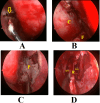Functional sinonasal outcomes after rescue flap versus double nasoseptal flap in endoscopic trans-sphenoid pituitary surgery: a randomized clinical trial
- PMID: 40220183
- PMCID: PMC12055946
- DOI: 10.1007/s00405-025-09342-8
Functional sinonasal outcomes after rescue flap versus double nasoseptal flap in endoscopic trans-sphenoid pituitary surgery: a randomized clinical trial
Abstract
Objectives: The aim of the current study was to evaluate the functional sinonasal outcomes after rescue flap versus double nasoseptal flap in endoscopic endonasal pituitary surgery.
Methods: This randomized clinical trial was conducted over 1.5 years over 60 patients who underwent endoscopic trans-sphenoid surgery for macroadenomas (more than 2 cm.). the patients were randomly allocated into 2 groups: the rescue flap group, (n = 30) and the double nasoseptal flap group (n = 30). Functional sinonasal outcomes were evaluated in both groups in terms of sinonasal outcome test (SNOT-22), crusting, adhesions, and olfaction.
Results: the sinonasal outcome test (SNOT-22), as well as the olfaction scores were significantly better in the double flap group compared to the rescue flap group. Crusting and adhesions occurred more frequently in the rescue flap group. The nasal stage operative time was significantly longer in the double flap group than the rescue flap group.
Conclusion: Endoscopic pituitary surgery can adversely affect the sinonasal functions. Double nasoseptal flap technique allows posterior septectomy with bilateral septal mucosa preservation. Although it requires longer operative time than the rescue flap technique, better functional sinonasal outcomes and olfaction scores are achieved.
Keywords: Nasoseptal flap; Outcomes; Pituitary adenoma; Rescue flap; Sinonasal; Trans-sphenoid.
© 2025. The Author(s).
Conflict of interest statement
Declarations. Ethics approval: The study was approved by the Mansoura Faculty of Medicine Institutional Research Board (IRB: MD.22.11.721.R1). This randomized clinical trial was registered at ClinicalTrials.gov (NCT06526481). Informed consent: Informed consent was obtained from all individual participants included in the study. Conflict of interest: The authors declare that they have no conflict of interest.
Figures



Similar articles
-
Analysis of Olfaction after Bilateral Nasoseptal Rescue Flap Transsphenoidal Approach with Olfactory Mucosal Preservation.Otolaryngol Head Neck Surg. 2019 Nov;161(5):881-889. doi: 10.1177/0194599819861340. Epub 2019 Jul 23. Otolaryngol Head Neck Surg. 2019. PMID: 31331243
-
Impact of nasoseptal flap elevation on sinonasal quality of life in endoscopic endonasal approach to pituitary adenomas.Eur Arch Otorhinolaryngol. 2016 May;273(5):1199-205. doi: 10.1007/s00405-015-3729-z. Epub 2015 Jul 29. Eur Arch Otorhinolaryngol. 2016. PMID: 26220192
-
The application of nasoseptal "rescue" flap technique in endoscopic transsphenoidal pituitary adenoma resection.Neurosurg Rev. 2020 Feb;43(1):259-263. doi: 10.1007/s10143-018-1048-8. Epub 2018 Dec 11. Neurosurg Rev. 2020. PMID: 30535967 Free PMC article.
-
Minimizing morbidity in endoscopic pituitary surgery: outcomes of the novel nasoseptal rescue flap technique.Otolaryngol Head Neck Surg. 2012 Sep;147(3):434-7. doi: 10.1177/0194599812443042. Epub 2012 Apr 6. Otolaryngol Head Neck Surg. 2012. PMID: 22492297
-
Olfactory function in patients after transsphenoidal surgery for pituitary adenomas-a short review.Neurosurg Rev. 2019 Jun;42(2):395-401. doi: 10.1007/s10143-018-1034-1. Epub 2018 Oct 1. Neurosurg Rev. 2019. PMID: 30276575 Review.
References
-
- Rotenberg B, Tam S, Ryu WHA, Duggal N (2010) Microscopic versus endoscopic pituitary surgery: a systematic review. Laryngoscope 120(7):1292–1297 - PubMed
-
- Sowerby LJ, Gross M, Broad R, Wright ED (2013) Olfactory and sinonasal outcomes in endoscopic transsphenoidal skull-base surgery. Int Forum Allergy Rhinology 3:217–220 - PubMed
-
- Hong SD, Nam D-H, Park J, Kim HY, Chung S-K, Dhong H-J (2014) Olfactory outcomes after endoscopic pituitary surgery with nasoseptal rescue flaps: electrocautery versus cold knife. Am J Rhinol Allergy 28(6):517–519 - PubMed
Publication types
MeSH terms
LinkOut - more resources
Full Text Sources
Medical

